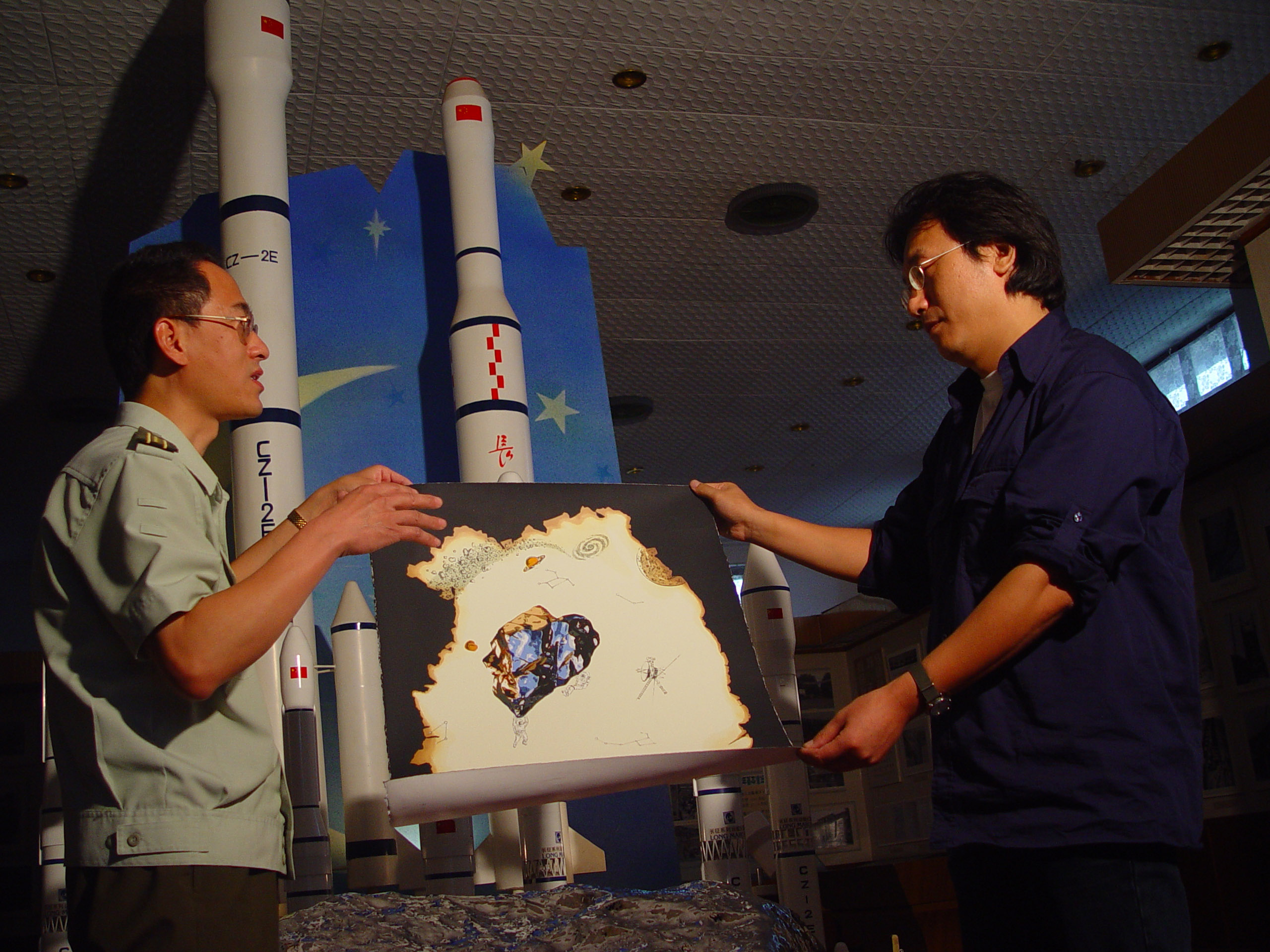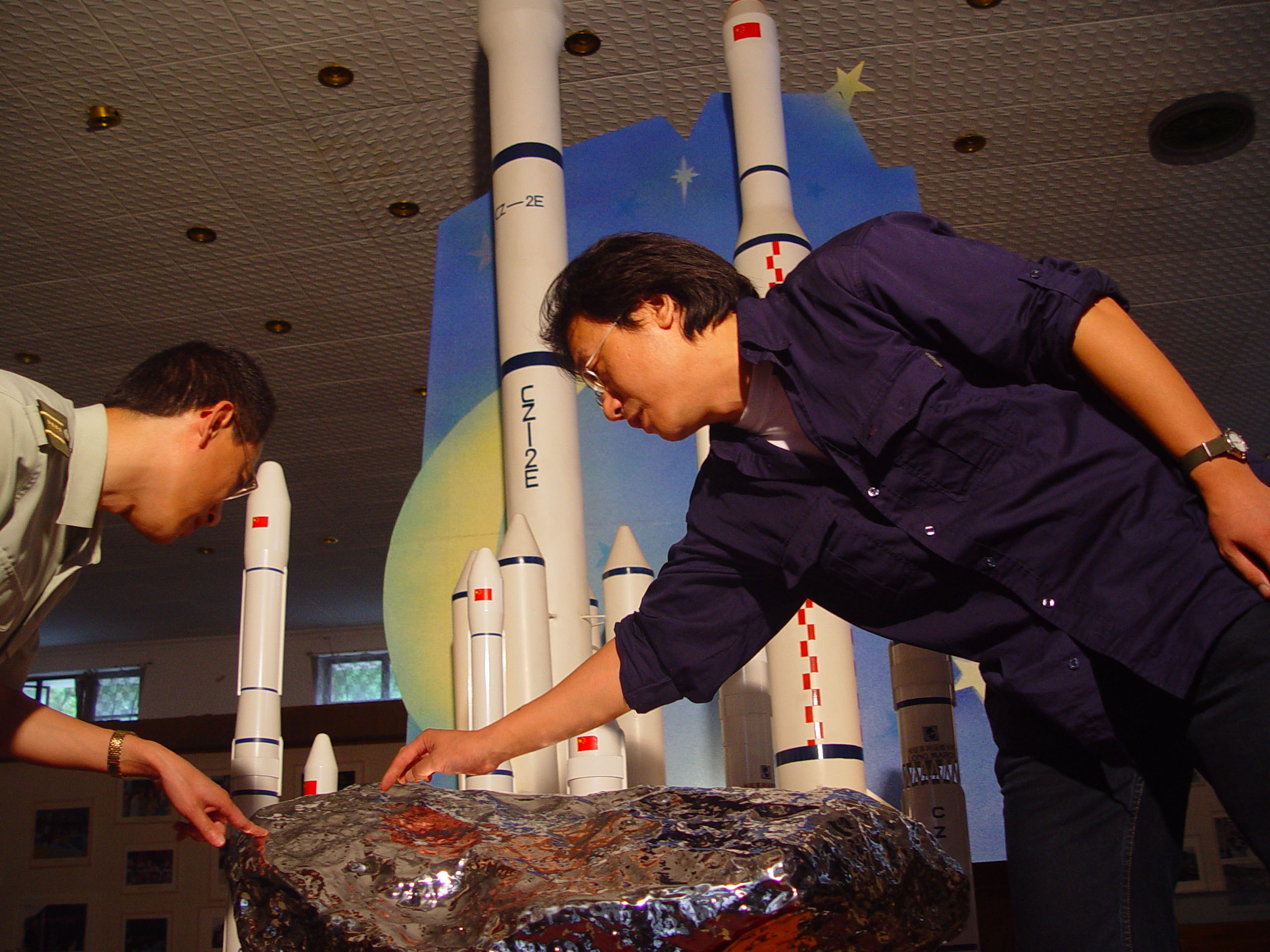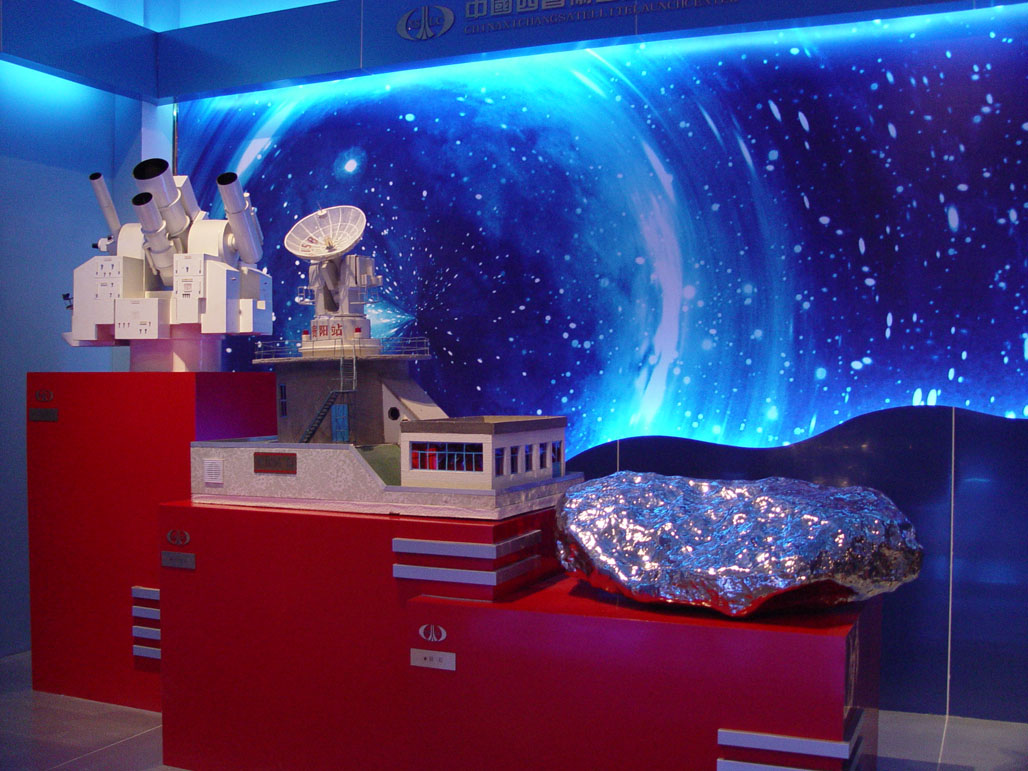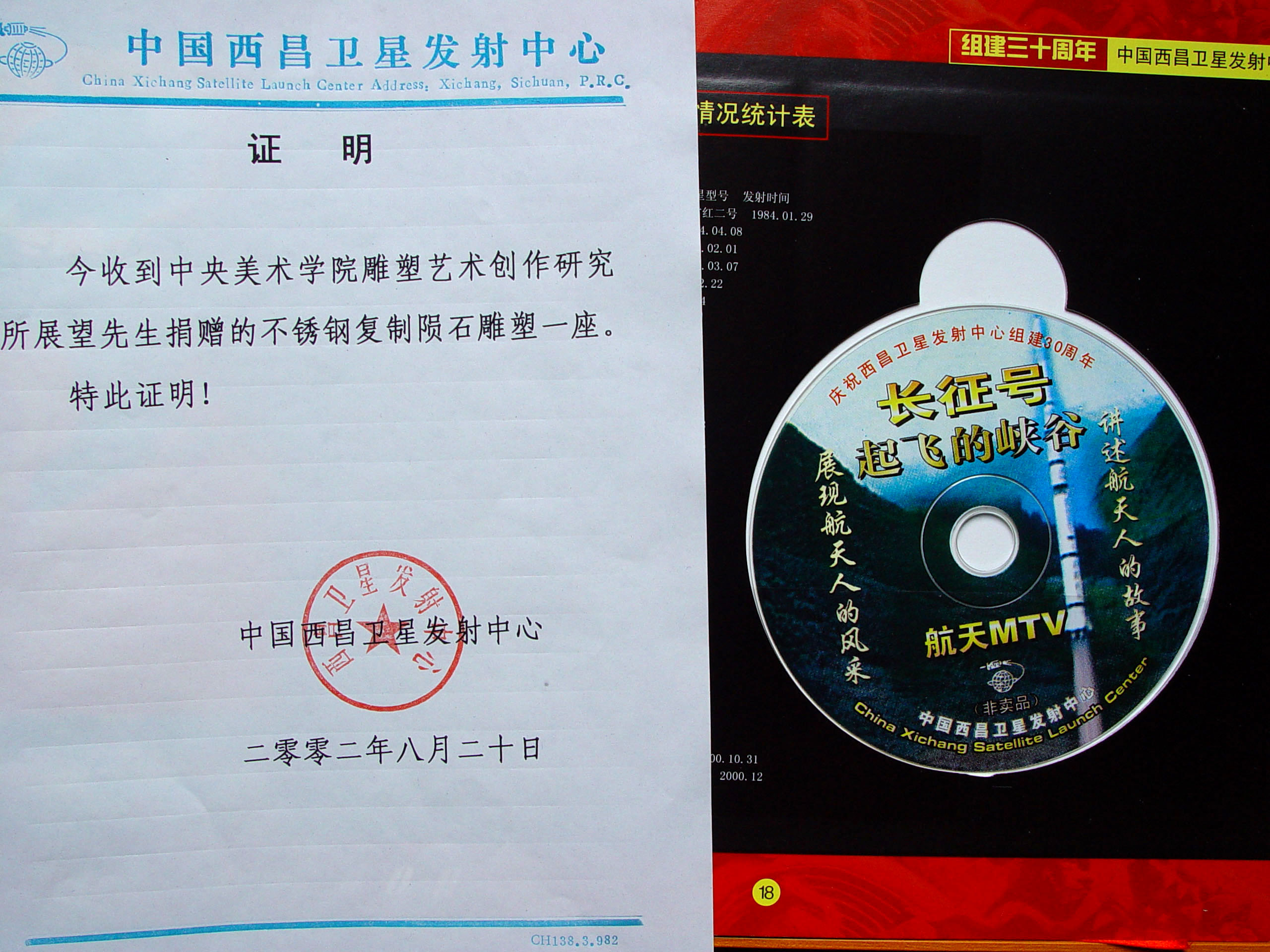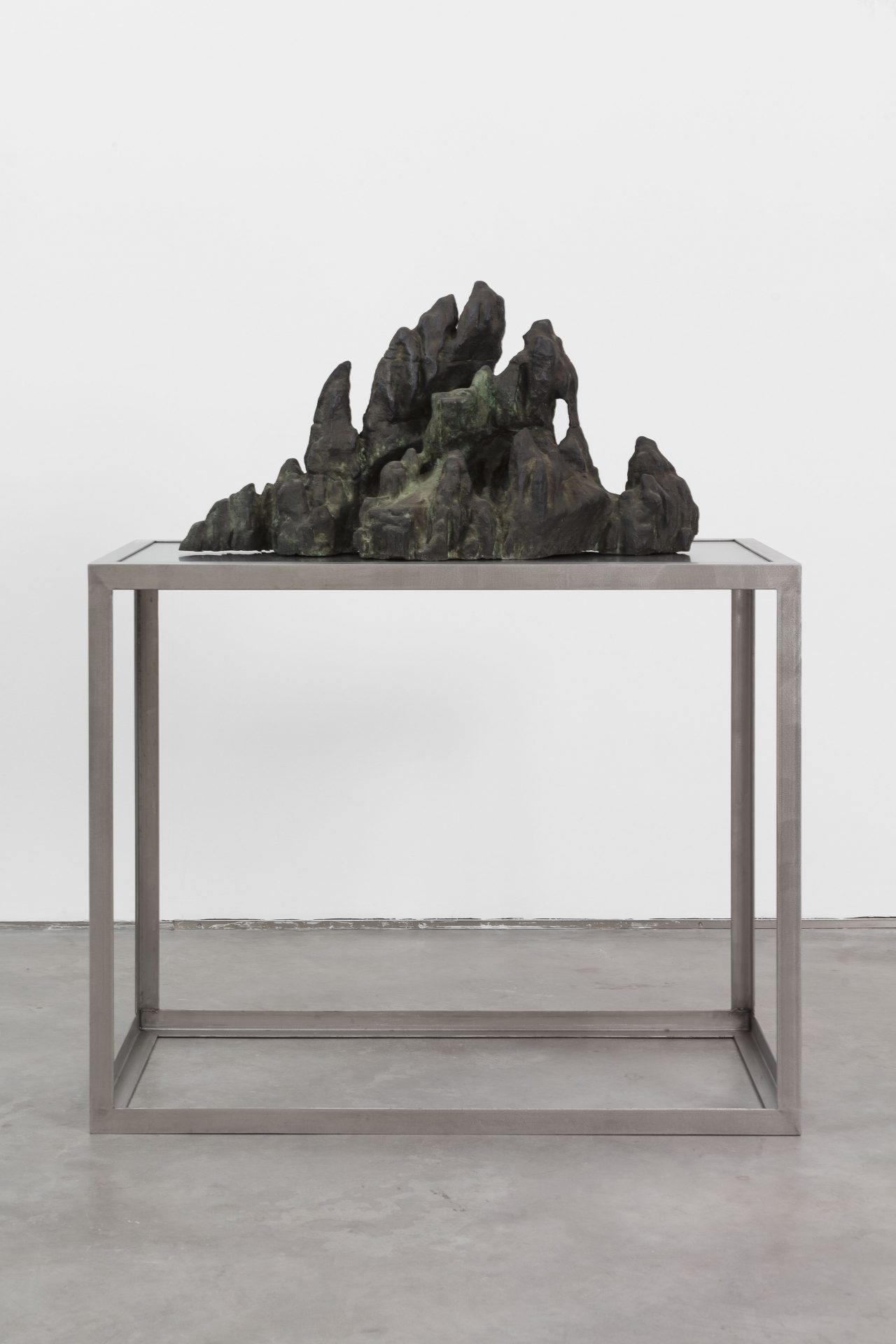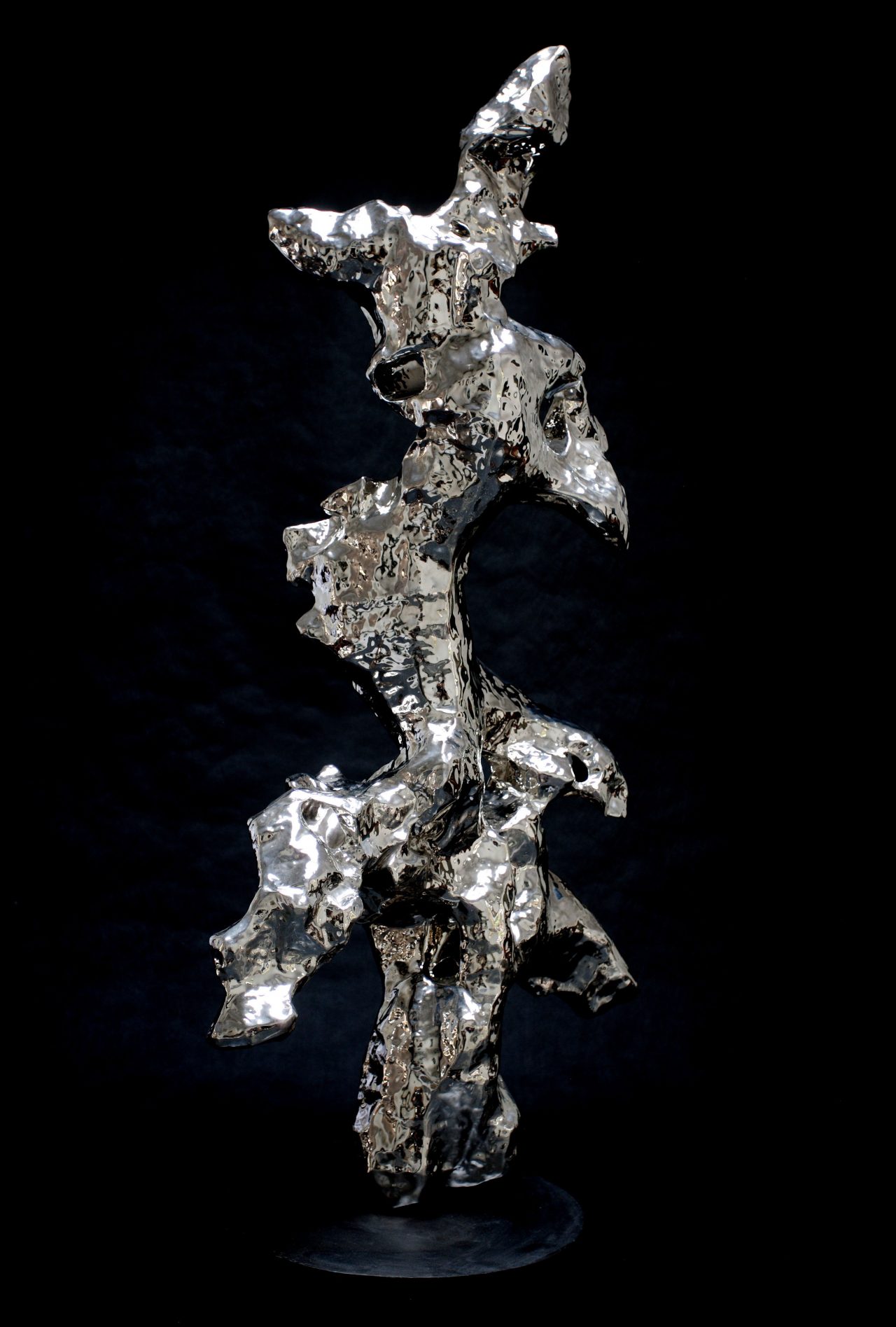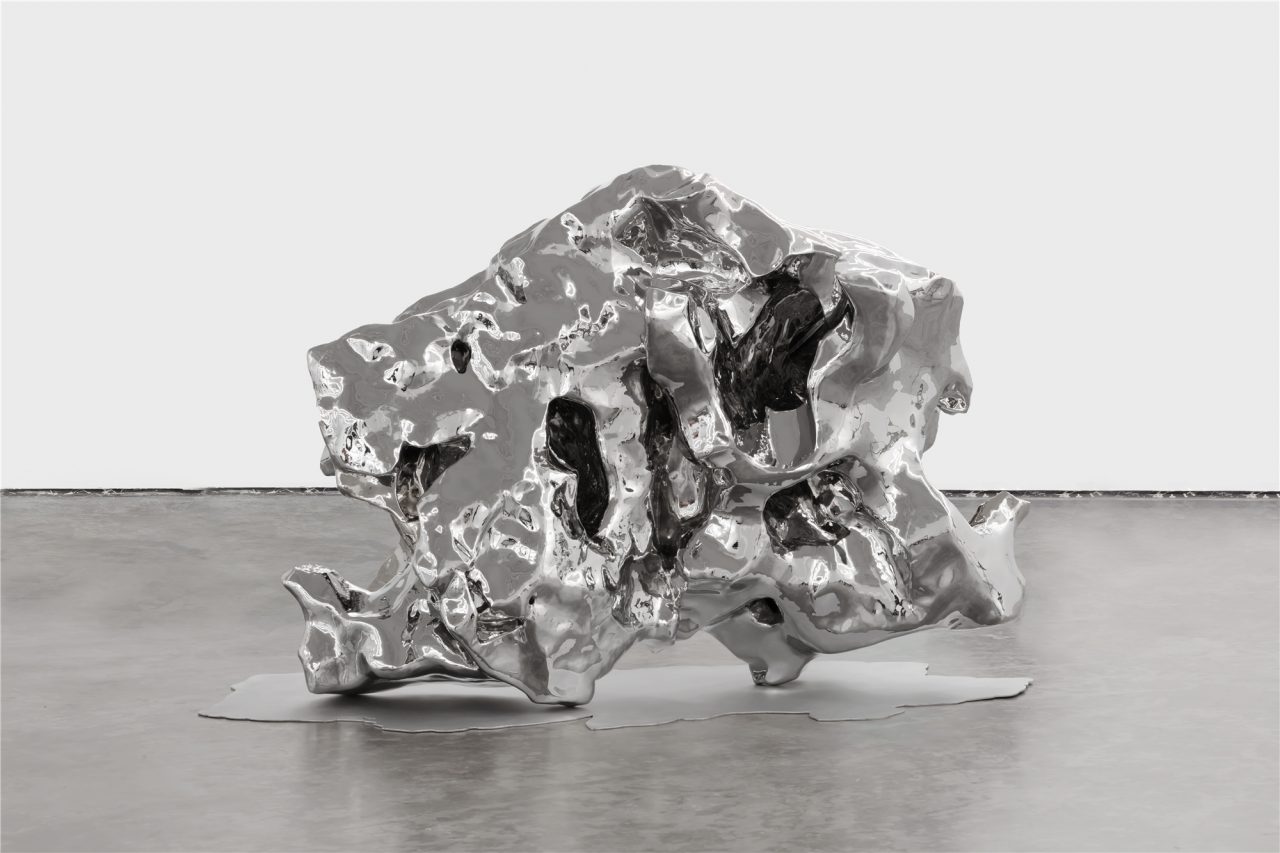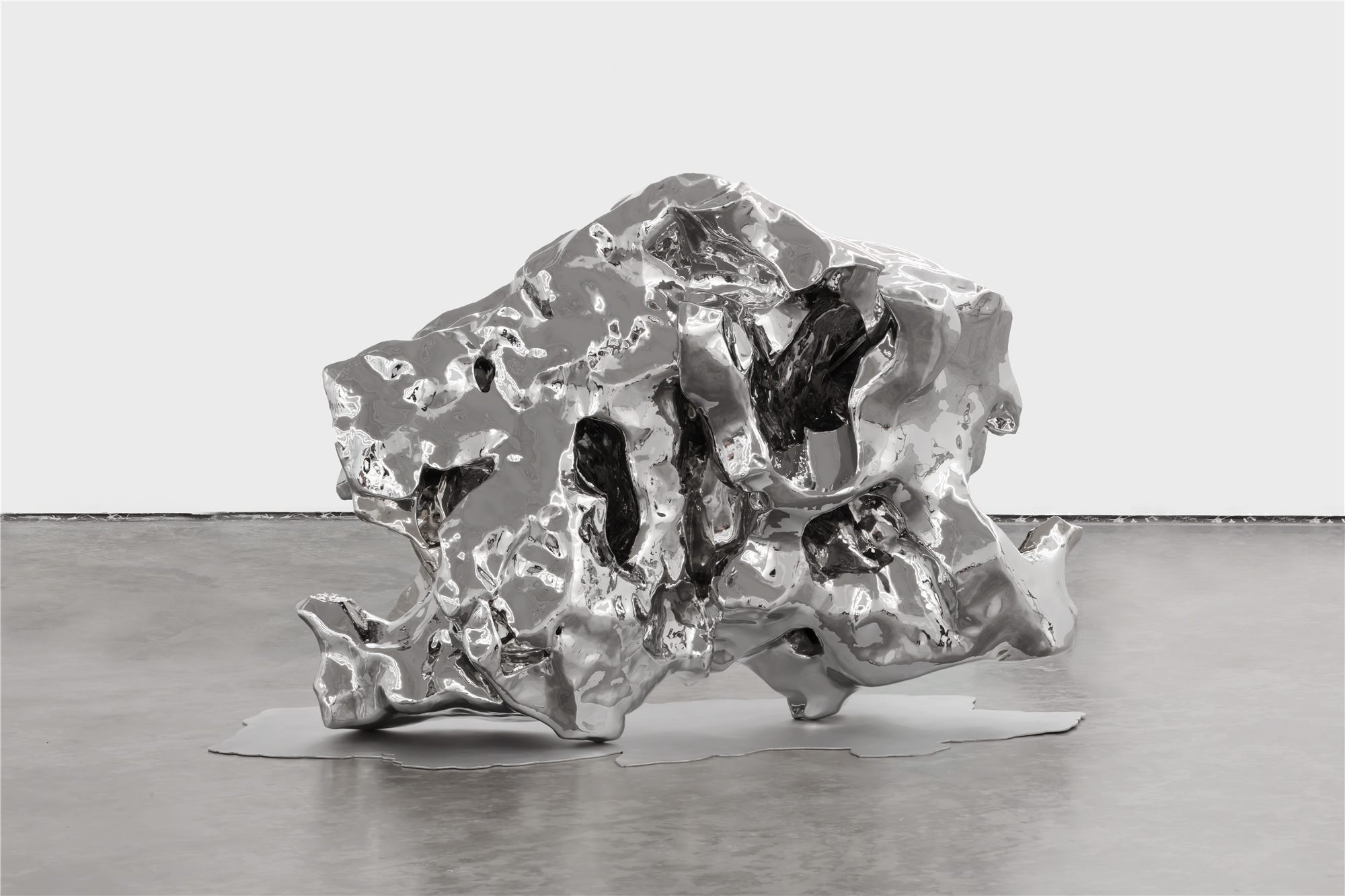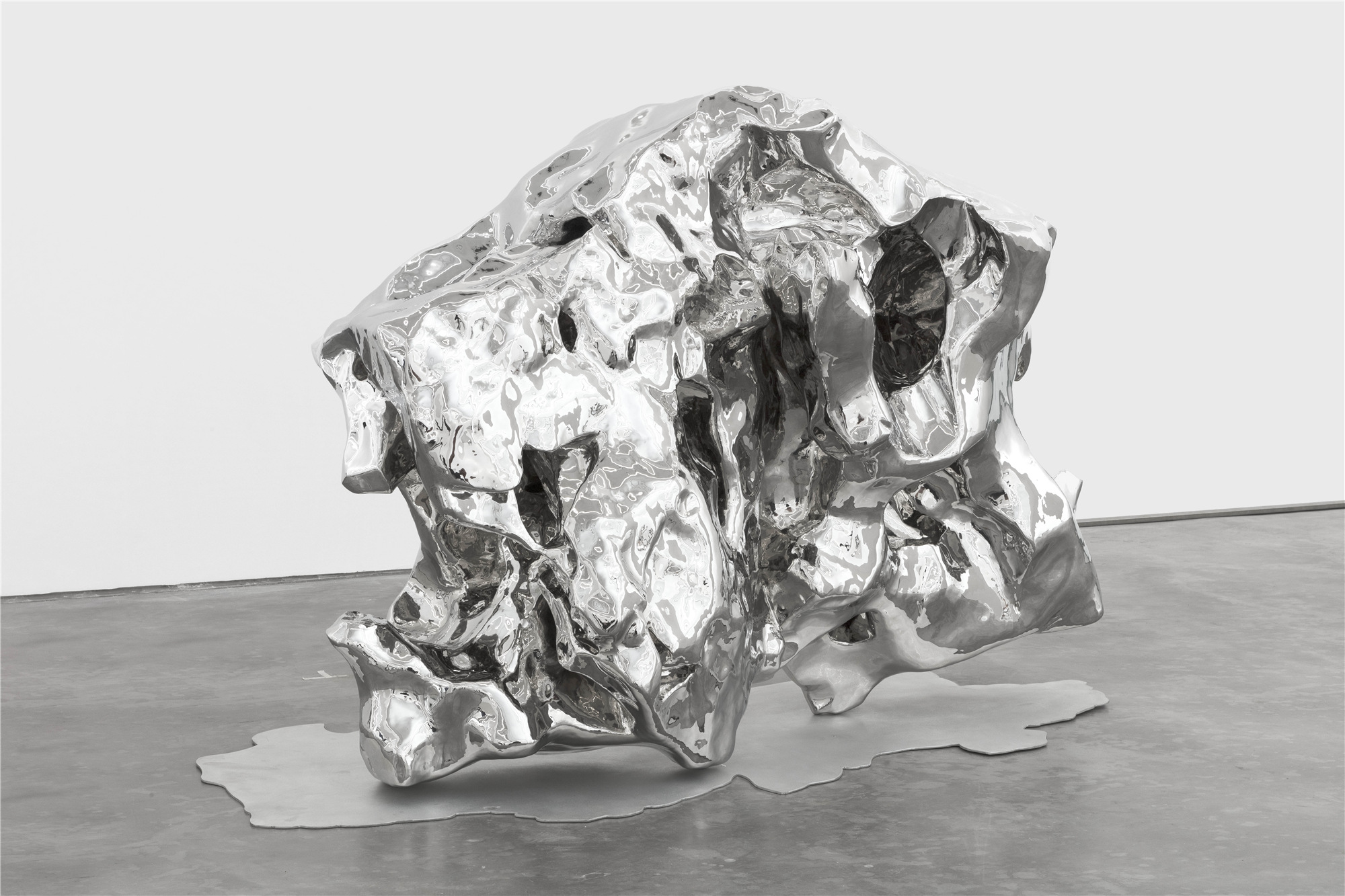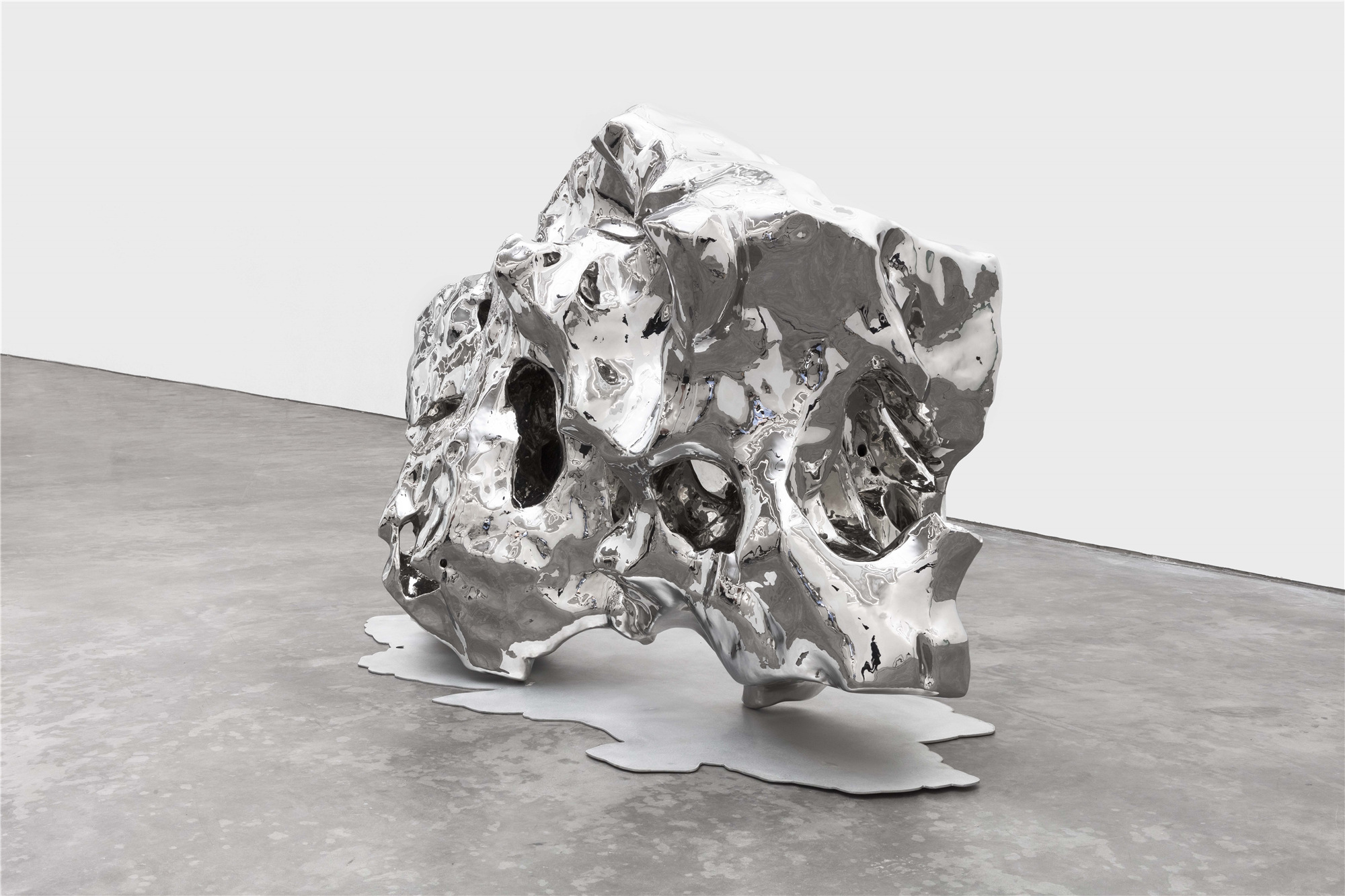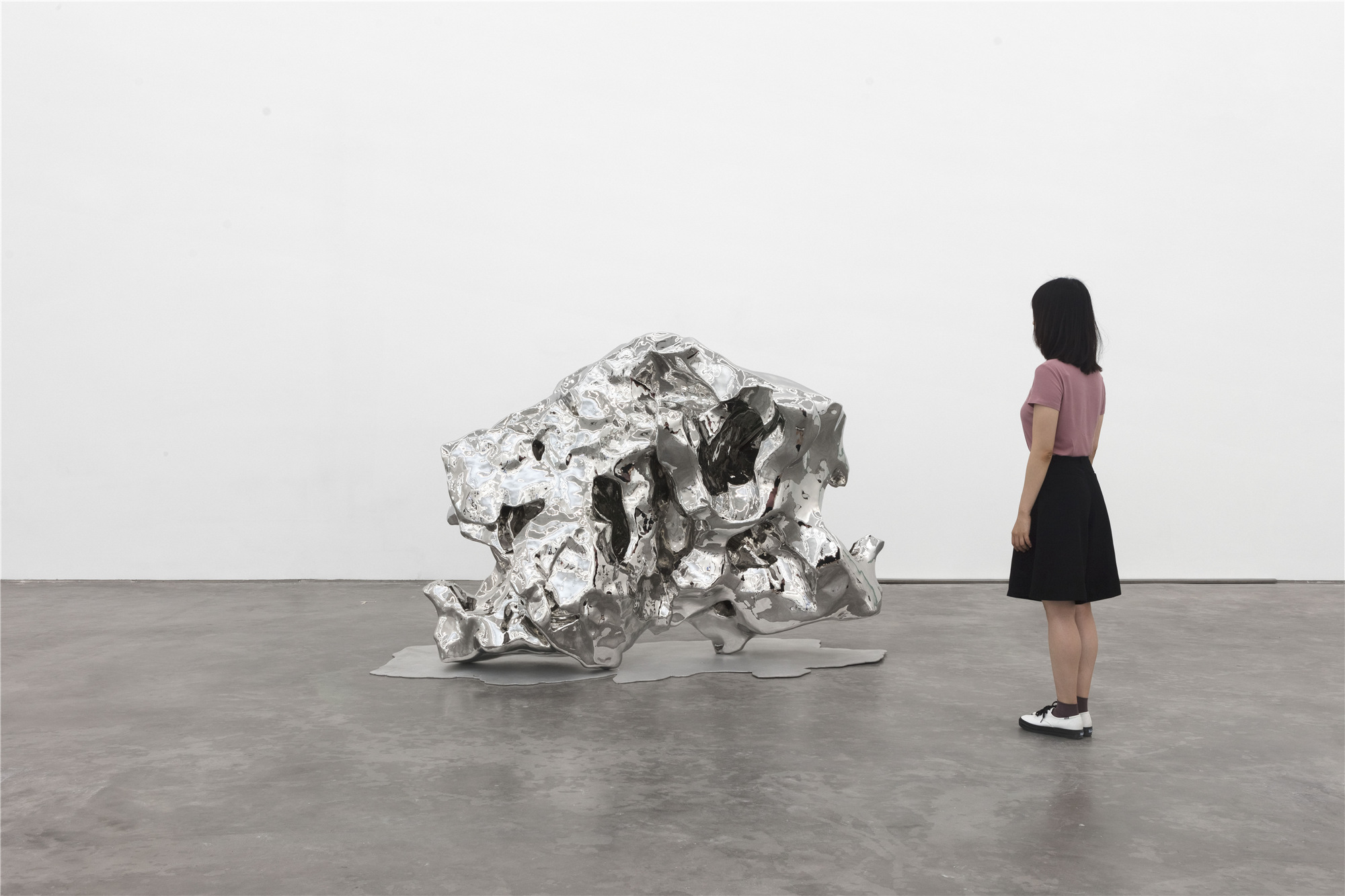Zhan Wang:Three Stories of the Stone
This online viewing room will present “Artificial Rock”—the most representative sculpture series by Zhan Wang. From the first “Artificial Rock” in 1995, the works this series have been collected by various museums, art institutions and private collectors throughout the world. The online viewing room will be launched from 15 August 18:00 to 21 August 24:00 (CST).
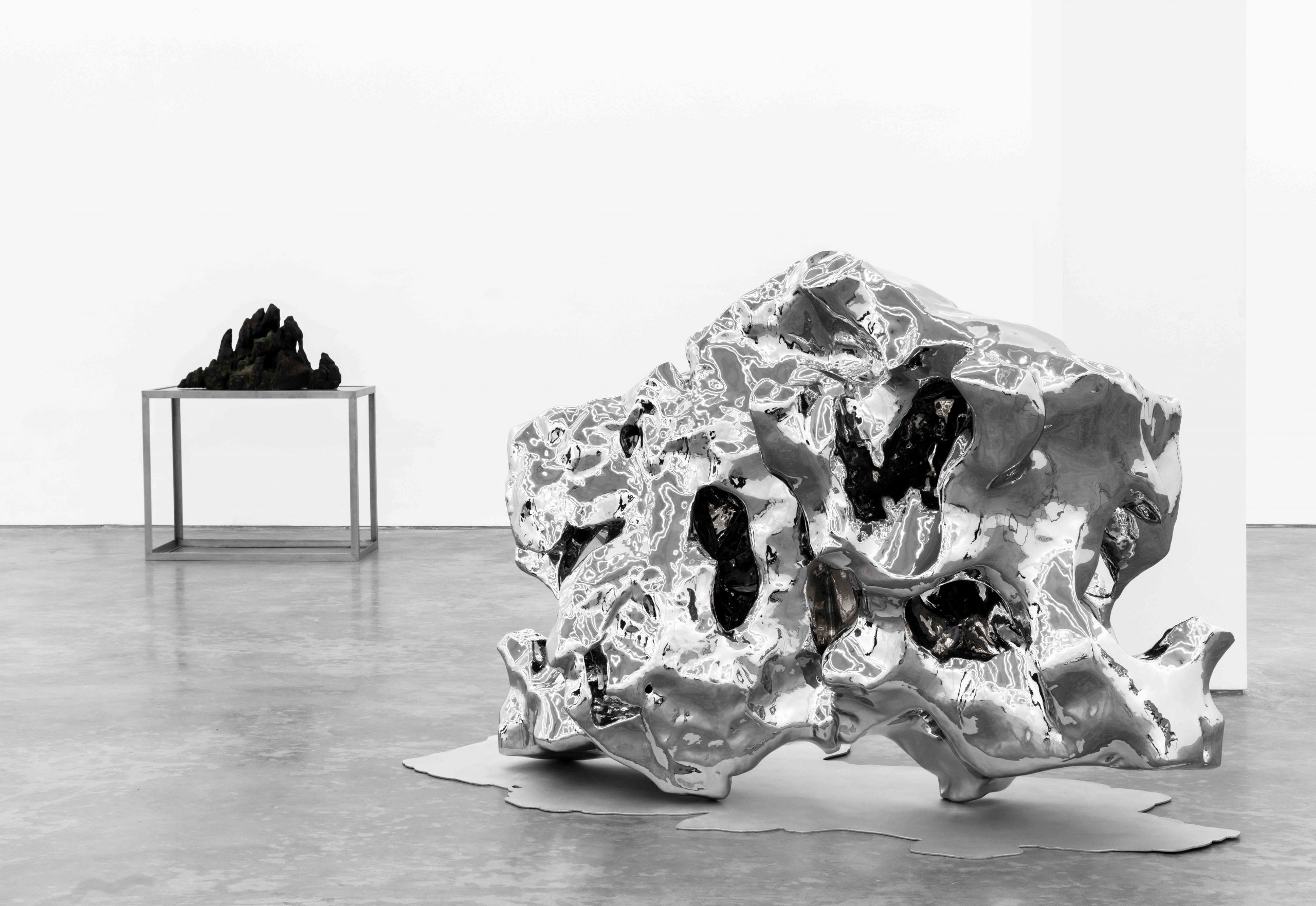
“Today, real life lies hidden in fantasies beneath dazzling surfaces, in stones now made hollow.”
— Zhan Wang, 1995
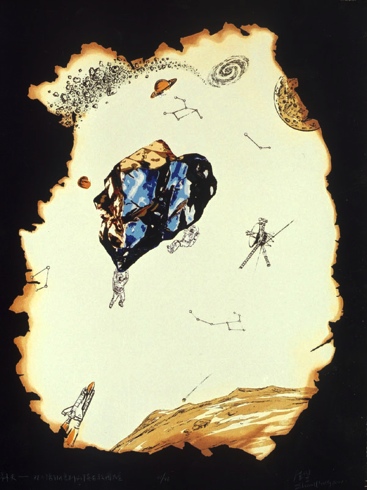
Sketch for New Plan to Fill the Sky, Image provided by Zhan Wang Studio
1. New Plan to Fill the Sky
The idea for the New Plan to Fill the Sky came about in 1999. In May 1999, I visited the Beijing Planetarium for the first time, hoping to reproduce one of the meteorites that they were exhibiting but I was rejected. Afterward I did the New Plan to Fill the Sky for the first time and it was called “Meteorite Plan”. After the plan of Floating Rock of the Open Sea was finished in the next year, I went to Beijing Planetarium for the second time and told them that plan. Although they still could not understand what I really wanted, they were moved by my persistence. So they would agree to my request to reproduce the meteorite but I needed to give them a copy. In the 2003, with this stainless steel replica meteorite I participated in Long March: A Walking Visual Display at the Xichang Satellite Launch Center. With the assistance of the two curators, I communicated and interacted with a military officer at the base. We came up with the following agreement: the Satellite Launch Center would collect this stainless-steel meteorite and would put it on long-term display in the “Hall of Space-Soaring Zhan Wang”, waiting for chances to do so.
On November 30, 2003, the Central Academy of Fine Arts organized a press conference for the successful launch of the “Shenzhou 5” spacecraft. With the help of Yang Li, Secretary of the Central Academy if Fine Arts, it was arranged for me to meet General Lou Mingshan and Lin Xuheng, assistant director of the 921 Engineering Headquarters of the Chinese Satellite Launch Center. I explained New Plan to Fill the Sky to them and presented them a complete set of the plans. They were extremely interested in this. Finally, Assistant Director Lin sighed: “Since the [spacecraft] technology that our country now has does not allow us to open portals in space, we still have no way of sending your ‘meteorite’ to outer space. It seems that we have only realized our dream of ‘flying through the sky,’ but not the dream of ‘patching up the sky!’” In 2004, the stainless steel replica of the meteorite was exhibited in The Monk and the Demon, an exhibition of Chinese contemporary art held in Lyon, France.
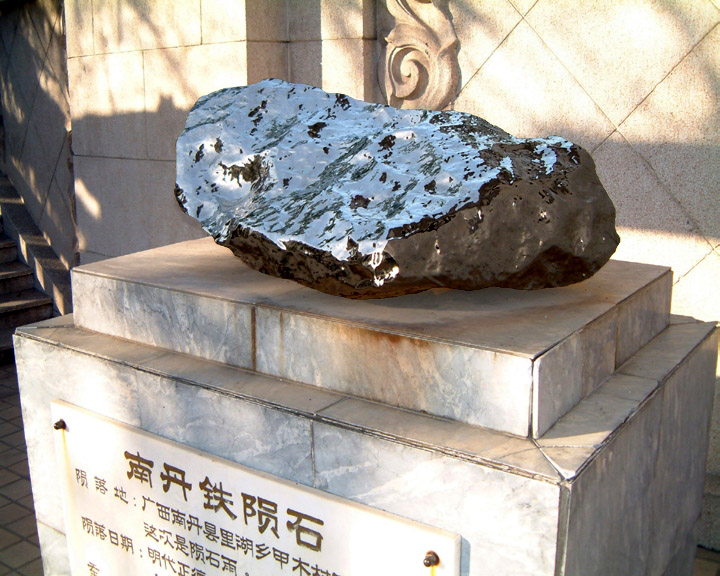
A copy of the Ming dynasty meteorite displayed in Beijing Planetarium, Image provided by Zhan Wang Studio
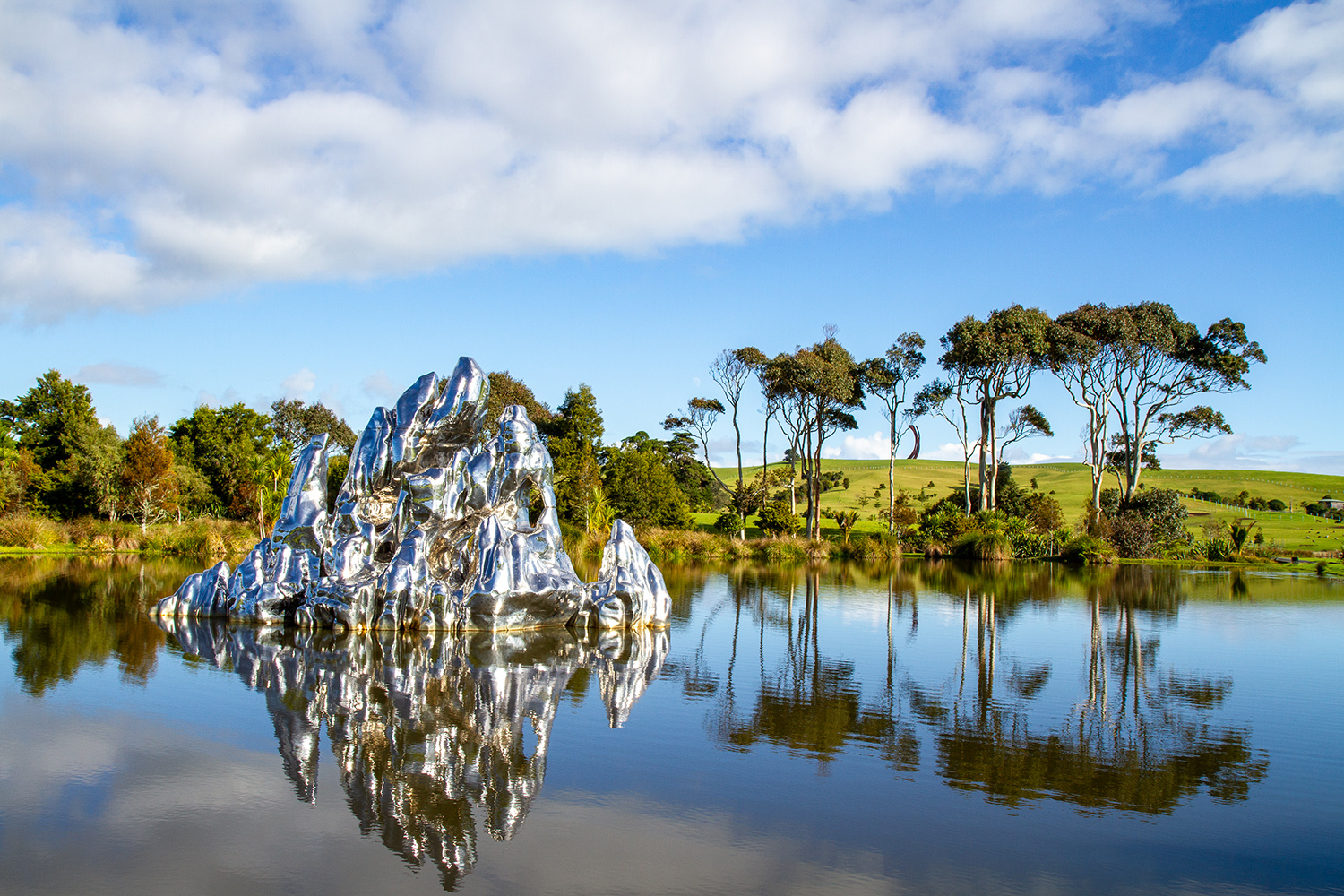
Floating Mountain of Immortals collected by Alan and Jenny Gibbs, Displayed at The Gibbs Farm, Kaipara Harbour, New Zealand, Image provided by Alan Gibbs Farm
2. Floating Mountain of Immortals
This work was created specifically for the Beaufort Triennial by the Sea in Belgium, which was curated by Willy van den Bussche, director of the PMMK Museum of Modern Art. Although the work entitled Floating Mountain of Immortals was another “scholars’ rock” reproduced in stainless steel, it was different from earlier works in that the stone to be copied was not a large, natural rock that had been purchased but rather transforming a small rock into a mountain. It was 4.8 meters tall and 8.6 meters wide. Thus, this mountain melded into my vision of a mountain of immortals. The making method was the same as before which is knock the stainless steel and polish it, a shiny and modern “mountain of immortal” was done.
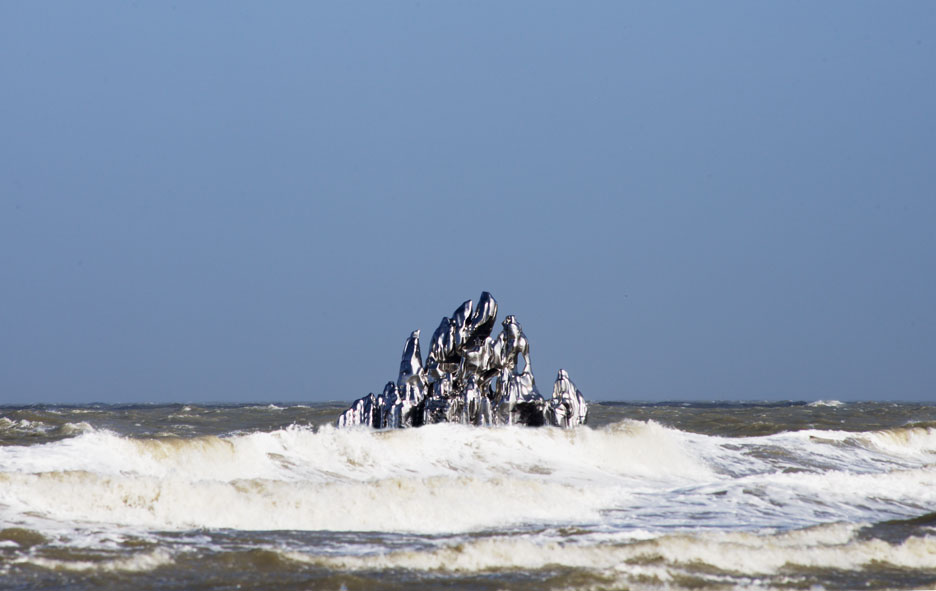
Floating Mountain of the Immortals, 2006, Stainless steel, 860 x 480 x 400 cm, Ostend, Belgium, Image provided by Zhan Wang Studio
The place where it was displayed was a part of Belgium’s coastline near the Netherlands. A large boat towed the work to the site, following the coastline and dropped the anchor at approximately one-hundred meters from shore. Beneath the boat, two large metal shafts sunk to the ocean floor. When the tide rose, it would sway about, following the undulations of the sea and when the tide receded to its lowest point, it would rest on the sand bank itself, completely exposed. People might even be able to “climb the mountain.” This is like an imaginary, solitary island, a modern “mountain of immortals” that has floated out from China. But for people who live in between the traditional and the modern, their situation remains unchanged—almost as though they are maintaining a certain attitude of calmness even as they drift about, unfixed. Today is Europe and tommorrow could be anywhere in the world. From the point of view of those at that old European vacation spot on the Belgian seashore, it seemed that these people who had drifted over from far-off China still believed in the power of nature but had no idea where their next stop might be!
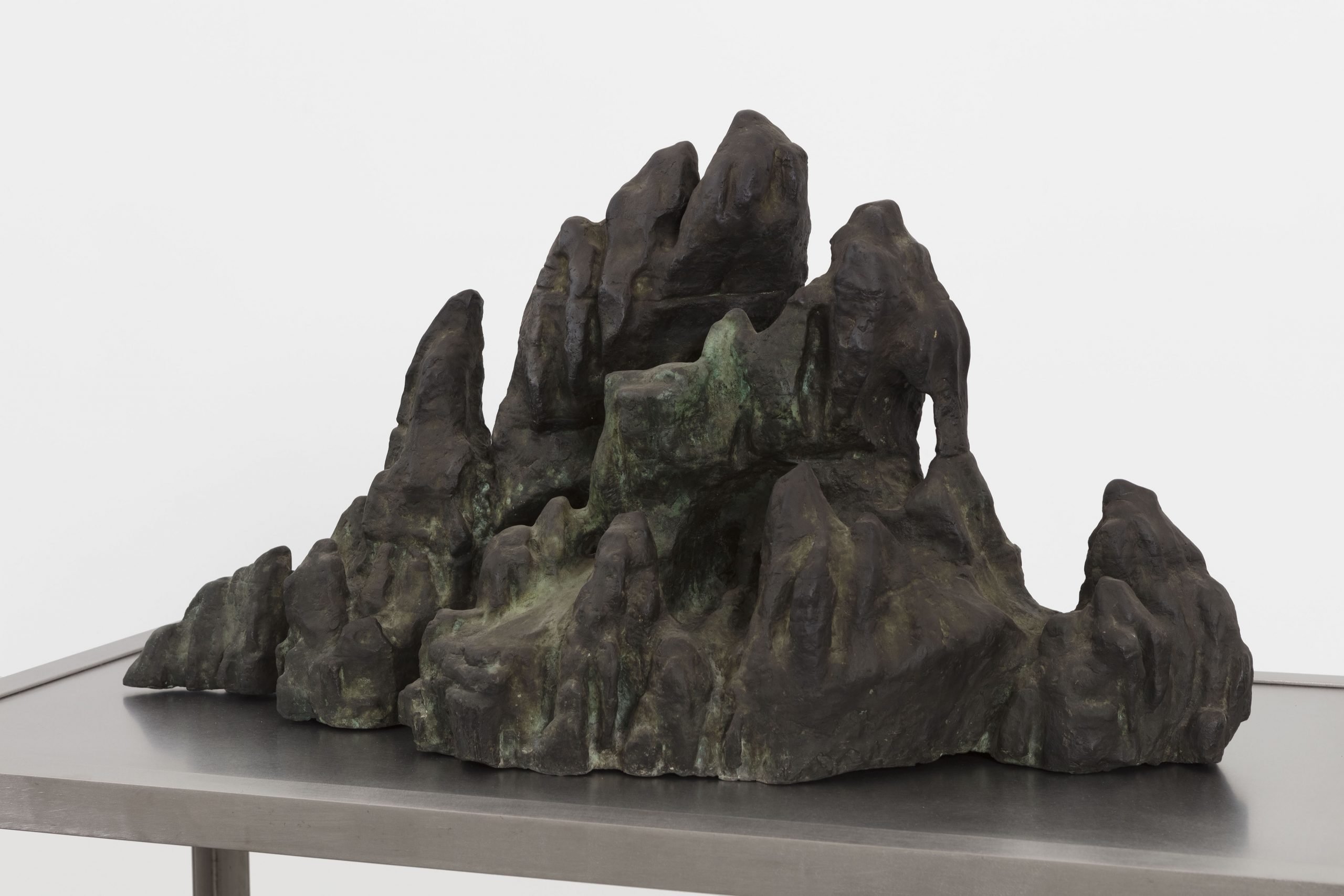
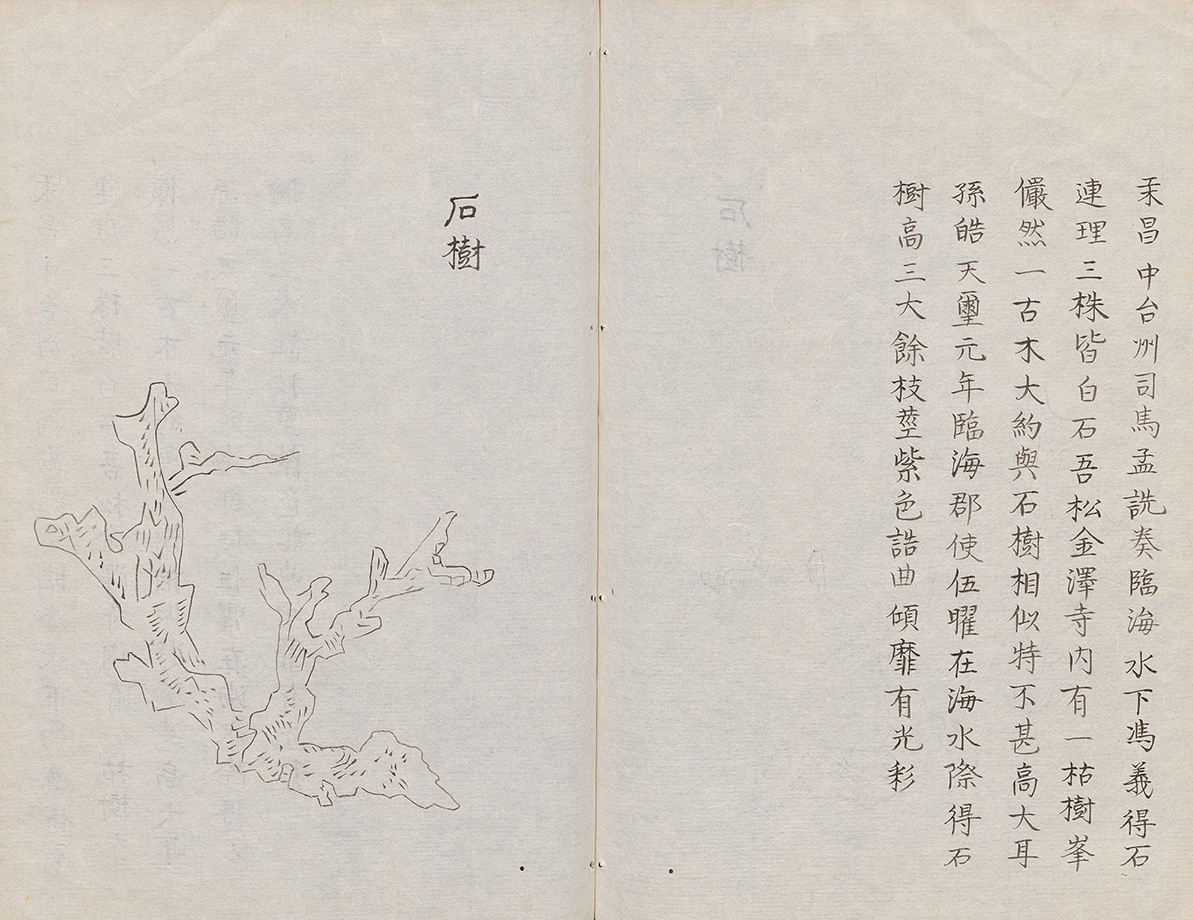
The Suyuan Stone Catalogue, Image from Internet
3. The Tree-rock
Shishu literally means “tree-like rock.” It does not refer to wood that has turned into stone (a kind of petrified wood), but rather to a rock that has grown into the shape of a tree. This is written in Suyuan Stone Catalogues. How rocks manage to become tree-shaped is hard to tell. But the power of nature can create anything beyond your imagination. Here is clearly a rock, and yet it has the form and the aura of a tree. But in material it remains a rock. The interest in this kind of rock is precisely that they are neither one nor the other When I turned this rock into a stainless-steel object reflecting gold and other colors, it was no longer a tree, but neither was it a rock—so there was an added layer of negation. The only certainty was that it had only fake identities: fake tree, fake rock, or fake tree-rock.
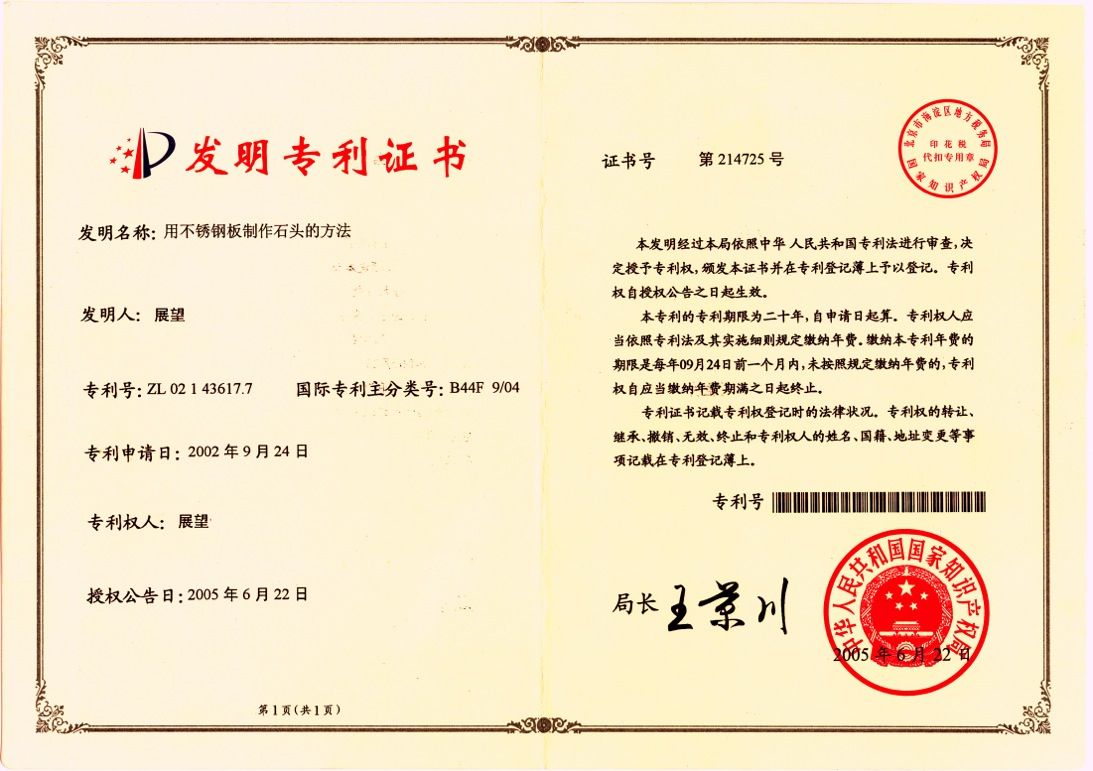
The patent for Zhan Wang's Stainless steel jiashanshi technology, Image provided by Zhan Wang Studio
Phases of Stainless Steel Jiashanshi Technology
Step 1: Choosing the Stone
The chosen stone can be any natural piece of rock
Step 2: Choosing the Material
Choose a plate of stainless steel material that is corrosion resistant and has a thickness between 0.8-1.5mm.
Step 3: Laying Down the Materials
Along the rock’s protruding edges, divide the entire surface of the stone into several large sections, and then use paper on the rock to make rubbings of approximate plate images. Cut along the approximations as placed on top of the steel plates.
Step 4: Making the rubbing images
After the already-cut stainless steel plates have been set on the corresponding areas of the stone, repeatedly hammer out the steel until the natural veins of the rock appear. Rubbings must also be made of the relatively deep concave areas of the rock’s surface.
Step 5: Hammering
For forging the relatively even areas of the rock’s surface, a padding of iron must be laid under while striking. The whole surface can also be forged with a hammering method to more or less pound out the form of each section.
Step 6: Soldering
Take the already hammered sections of stainless steel and connect them while on the rock’s surface, proceed to set them by spot welding. When the last section of stainless steel plate remains take the near-completely spot
soldered shell off of the rock and fill all of the soldering areas with solder. Afterward, solder on the last plate of stainless steel to form a complete empty shell of the rock.
Step 7: Burnishing
Proceed to burnish the already soldered and hammered surface. Use sandpaper to burnish the hammered areas, first using rough grit and then lastly, a very fine grit paper.
Step 8: Polishing
Polish directly on the waxed metal surface with a circular cloth polishing machine. Do this repeatedly until the surface is like a mirror.
—excerpt from the Invention Patent Manual
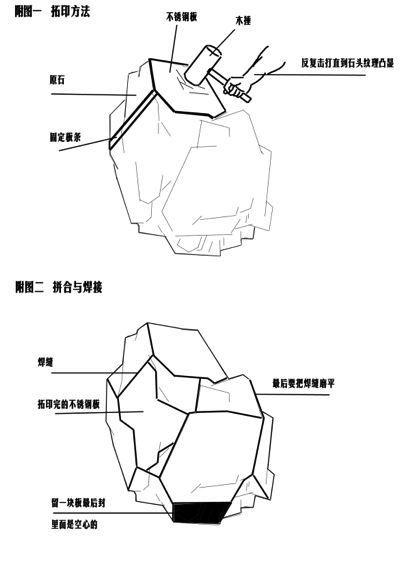
Illustration for the patent, Image provided by Zhan Wang Studio
When building a garden, the Chinese often use real mountain rocks to simulate a mountain view; this feature is colloquially referred to as an “artificial rockery.” What then, should we place in front of a new building? My experiment was to turn an artificial rockery into a sculpture, a reflection of my contemplations. Normally, “realness” lies in plain nature, while its opposite—the artificial world—is considered “fake.” But when we see this fake rock made of stainless-steel (using the stone-rubbing technique), the real appears to be fake and the fake appears to be real, echoing the quote “illusion is reality, reality illusion.” Stainless steel is an upgraded alloy technology invented for in contemporary society; it makes so-called “rust-free” metal possible. This unnatural desire fulfils a genuine pursuit of modern people, while the return to true nature has become mere wishful thinking. This contradictory logic is mirrored on the rock’s polished surface, mixing the artificial with the natural, fusing tradition with modernity.
The shapes of my “Artificial Rocks” follow the theorem that no two rocks in nature are alike. This was the first time I joined two identical artificial rocks in reverse to create a rock that was impossible to find in nature—it is balanced, but not symmetrical (not a mirror image). It further explores the artificial concept of “artificiality.”
Contents are selected from The New Suyuan Stone Catalogue, Zhan Wang, Life·Read·Knowledge Sanlian Bookstore, 2008
Zhan Wang:Three Stories of the Stone
This online viewing room will present “Artificial Rock”—the most representative sculpture series by Zhan Wang. From the first “Artificial Rock” in 1995, the works this series have been collected by various museums, art institutions and private collectors throughout the world. The online viewing room will be launched from 15 August 18:00 to 21 August 24:00 (CST).

“Today, real life lies hidden in fantasies beneath dazzling surfaces, in stones now made hollow.”
— Zhan Wang, 1995
1. New Plan to Fill the Sky

Sketch for New Plan to Fill the Sky, Image provided by Zhan Wang Studio
The idea for the New Plan to Fill the Sky came about in 1999. In May 1999, I visited the Beijing Planetarium for the first time, hoping to reproduce one of the meteorites that they were exhibiting but I was rejected. Afterward I did the New Plan to Fill the Sky for the first time and it was called “Meteorite Plan”. After the plan of Floating Rock of the Open Sea was finished in the next year, I went to Beijing Planetarium for the second time and told them that plan. Although they still could not understand what I really wanted, they were moved by my persistence. So they would agree to my request to reproduce the meteorite but I needed to give them a copy. In the 2003, with this stainless steel replica meteorite I participated in Long March: A Walking Visual Display at the Xichang Satellite Launch Center. With the assistance of the two curators, I communicated and interacted with a military officer at the base. We came up with the following agreement: the Satellite Launch Center would collect this stainless-steel meteorite and would put it on long-term display in the “Hall of Space-Soaring Zhan Wang”, waiting for chances to do so.

A copy of the Ming dynasty meteorite displayed in Beijing Planetarium, Image provided by Zhan Wang Studio
On November 30, 2003, the Central Academy of Fine Arts organized a press conference for the successful launch of the “Shenzhou 5” spacecraft. With the help of Yang Li, Secretary of the Central Academy if Fine Arts, it was arranged for me to meet General Lou Mingshan and Lin Xuheng, assistant director of the 921 Engineering Headquarters of the Chinese Satellite Launch Center. I explained New Plan to Fill the Sky to them and presented them a complete set of the plans. They were extremely interested in this. Finally, Assistant Director Lin sighed: “Since the [spacecraft] technology that our country now has does not allow us to open portals in space, we still have no way of sending your ‘meteorite’ to outer space. It seems that we have only realized our dream of ‘flying through the sky,’ but not the dream of ‘patching up the sky!’” In 2004, the stainless steel replica of the meteorite was exhibited in The Monk and the Demon, an exhibition of Chinese contemporary art held in Lyon, France.
2. Floating Mountain of Immortals

Floating Mountain of Immortals collected by Alan and Jenny Gibbs, Displayed at The Gibbs Farm, Kaipara Harbour, New Zealand, Image provided by Alan Gibbs Farm
This work was created specifically for the Beaufort Triennial by the Sea in Belgium, which was curated by Willy van den Bussche, director of the PMMK Museum of Modern Art. Although the work entitled Floating Mountain of Immortals was another “scholars’ rock” reproduced in stainless steel, it was different from earlier works in that the stone to be copied was not a large, natural rock that had been purchased but rather transforming a small rock into a mountain. It was 4.8 meters tall and 8.6 meters wide. Thus, this mountain melded into my vision of a mountain of immortals. The making method was the same as before which is knock the stainless steel and polish it, a shiny and modern “mountain of immortal” was done.

Floating Mountain of the Immortals, 2006, Stainless steel, 860 x 480 x 400 cm, Ostend, Belgium, Image provided by Zhan Wang Studio
The place where it was displayed was a part of Belgium’s coastline near the Netherlands. A large boat towed the work to the site, following the coastline and dropped the anchor at approximately one-hundred meters from shore. Beneath the boat, two large metal shafts sunk to the ocean floor. When the tide rose, it would sway about, following the undulations of the sea and when the tide receded to its lowest point, it would rest on the sand bank itself, completely exposed. People might even be able to “climb the mountain.” This is like an imaginary, solitary island, a modern “mountain of immortals” that has floated out from China. But for people who live in between the traditional and the modern, their situation remains unchanged—almost as though they are maintaining a certain attitude of calmness even as they drift about, unfixed. Today is Europe and tommorrow could be anywhere in the world. From the point of view of those at that old European vacation spot on the Belgian seashore, it seemed that these people who had drifted over from far-off China still believed in the power of nature but had no idea where their next stop might be!

3. The Tree-rock

The Suyuan Stone Catalogue, Image from Internet
Shishu literally means “tree-like rock.” It does not refer to wood that has turned into stone (a kind of petrified wood), but rather to a rock that has grown into the shape of a tree. This is written in Suyuan Stone Catalogues. How rocks manage to become tree-shaped is hard to tell. But the power of nature can create anything beyond your imagination. Here is clearly a rock, and yet it has the form and the aura of a tree. But in material it remains a rock. The interest in this kind of rock is precisely that they are neither one nor the other When I turned this rock into a stainless-steel object reflecting gold and other colors, it was no longer a tree, but neither was it a rock—so there was an added layer of negation. The only certainty was that it had only fake identities: fake tree, fake rock, or fake tree-rock.
Phases of Stainless Steel Jiashanshi Technology
Step 1: Choosing the Stone
The chosen stone can be any natural piece of rock
Step 2: Choosing the Material
Choose a plate of stainless steel material that is corrosion resistant and has a thickness between 0.8-1.5mm.
Step 3: Laying Down the Materials
Along the rock’s protruding edges, divide the entire surface of the stone into several large sections, and then use paper on the rock to make rubbings of approximate plate images. Cut along the approximations as placed on top of the steel plates.

Illustration for the patent, Image provided by Zhan Wang Studio
Step 4: Making the rubbing images
After the already-cut stainless steel plates have been set on the corresponding areas of the stone, repeatedly hammer out the steel until the natural veins of the rock appear. Rubbings must also be made of the relatively deep concave areas of the rock’s surface.
Step 5: Hammering
For forging the relatively even areas of the rock’s surface, a padding of iron must be laid under while striking. The whole surface can also be forged with a hammering method to more or less pound out the form of each section.
Step 6: Soldering
Take the already hammered sections of stainless steel and connect them while on the rock’s surface, proceed to set them by spot welding. When the last section of stainless steel plate remains take the near-completely spot
soldered shell off of the rock and fill all of the soldering areas with solder. Afterward, solder on the last plate of stainless steel to form a complete empty shell of the rock.

The patent for Zhan Wang's Stainless steel jiashanshi technology,Image provided by Zhan Wang Studio
Step 7: Burnishing
Proceed to burnish the already soldered and hammered surface. Use sandpaper to burnish the hammered areas, first using rough grit and then lastly, a very fine grit paper.
Step 8: Polishing
Polish directly on the waxed metal surface with a circular cloth polishing machine. Do this repeatedly until the surface is like a mirror.
—excerpt from the Invention Patent Manual
When building a garden, the Chinese often use real mountain rocks to simulate a mountain view; this feature is colloquially referred to as an “artificial rockery.” What then, should we place in front of a new building? My experiment was to turn an artificial rockery into a sculpture, a reflection of my contemplations. Normally, “realness” lies in plain nature, while its opposite—the artificial world—is considered “fake.” But when we see this fake rock made of stainless-steel (using the stone-rubbing technique), the real appears to be fake and the fake appears to be real, echoing the quote “illusion is reality, reality illusion.” Stainless steel is an upgraded alloy technology invented for in contemporary society; it makes so-called “rust-free” metal possible. This unnatural desire fulfils a genuine pursuit of modern people, while the return to true nature has become mere wishful thinking. This contradictory logic is mirrored on the rock’s polished surface, mixing the artificial with the natural, fusing tradition with modernity.
The shapes of my “Artificial Rocks” follow the theorem that no two rocks in nature are alike. This was the first time I joined two identical artificial rocks in reverse to create a rock that was impossible to find in nature—it is balanced, but not symmetrical (not a mirror image). It further explores the artificial concept of “artificiality.”
Contents are selected from The New Suyuan Stone Catalogue, Zhan Wang, Life·Read·Knowledge Sanlian Bookstore, 2008

